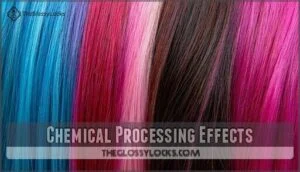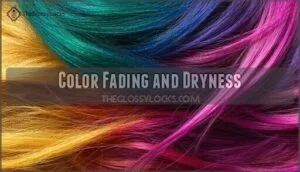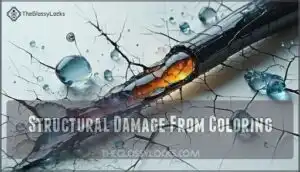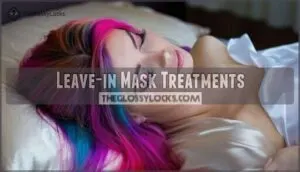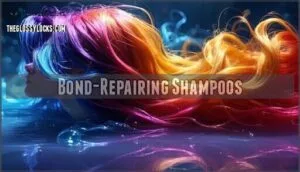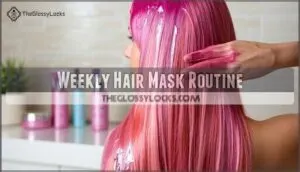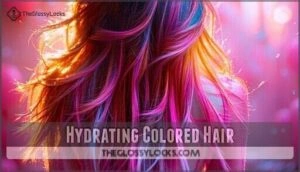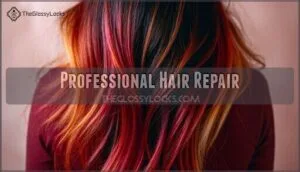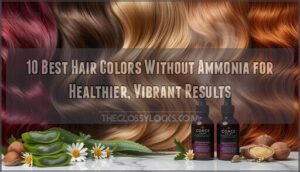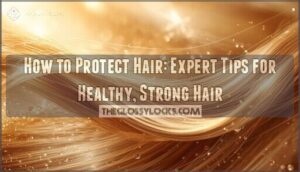This site is supported by our readers. We may earn a commission, at no cost to you, if you purchase through links.
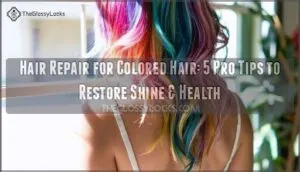
Start with bond-repairing shampoos that rebuild broken protein chains from bleaching and dyeing. Follow up with sulfate-free products that won’t strip your color while cleansing gently.
Weekly deep conditioning masks packed with keratin and natural oils work overtime to restore moisture and elasticity. Leave-in treatments create a protective barrier against future damage.
Professional salon treatments can tackle severe structural damage that at-home care can’t touch. The secret lies in understanding exactly which type of damage you’re dealing with and matching the right repair strategy to restore your hair’s health and elasticity.
Table Of Contents
- Key Takeaways
- Hair Damage Causes
- Repairing Colored Hair
- Hydrating Colored Hair
- Professional Hair Repair
- Maintaining Healthy Hair
- Frequently Asked Questions (FAQs)
- How do you repair damaged hair from coloring?
- What is the best treatment for coloured, damaged hair?
- How do you rehydrate colored hair?
- How do I get my hair healthy again after dying it?
- How often should I color my hair safely?
- Can heat styling damage colored hair further?
- What ingredients should I avoid in hair products?
- How long before I can swim after coloring?
- Conclusion
Key Takeaways
- Use bond-repairing shampoos to rebuild broken protein chains from chemical damage and restore your hair’s structural integrity
- Switch to sulfate-free products that won’t strip your color while gently cleansing and protecting your investment in hair treatments
- Apply weekly deep conditioning masks with keratin and natural oils to restore moisture, elasticity, and create a protective barrier against future damage
- Match your repair strategy to your specific damage type – consider professional salon treatments for severe structural damage that at-home care can’t address
Hair Damage Causes
When you color your hair, chemical processes break down the natural protein bonds that keep your strands strong and smooth.
This damage leads to dryness, fading, and weakened hair that’s prone to breakage and split ends.
Chemical Processing Effects
Chemical damage strikes at your hair’s core structure.
Color treatments attack the very foundation of your hair’s strength, breaking down essential protein bonds that keep strands resilient.
Permanent dyes require cuticle lifting, exposing inner layers to harsh ammonia and peroxide.
These chemicals break protein bonds and weaken keratin, causing measurable hair breakage and follicle stress.
Your colored hair loses tensile strength while cuticle damage increases porosity, making strands vulnerable to environmental stress and further color shift.
Understanding the risks of hair dye dangers is essential for maintaining healthy hair.
Color Fading and Dryness
Every time you color your hair, you’re basically opening the floodgates to moisture loss.
Color treatments turn your hair into a thirsty sponge, desperately craving moisture it can no longer hold.
Your hair cuticles lift during the coloring process, creating tiny escape routes for water and natural oils. This double whammy leads to that dreaded combination of fading color and parched strands.
- Harsh detergents in regular shampoos strip away color molecules and natural moisture
- UV exposure accelerates both color fading and dryness by breaking down pigments
- Heat styling on color treated hair creates additional moisture loss and faster fading
Structural Damage From Coloring
Coloring your hair breaks down protein bonds inside each strand.
This hair fracture weakens your hair’s structure and leads to follicle damage over time.
The chemical process strips away natural protective layers causing cuticle repair needs.
Pigment loss occurs when damaged hair can’t hold color properly.
Hair strengthening treatments become essential for color treated hair restoration.
Repairing Colored Hair
When you color your hair, the chemical processes break down your hair’s natural protein bonds and strip away moisture.
Your colored strands need targeted repair treatments to rebuild strength and restore their healthy shine.
Leave-in Mask Treatments
Leave-in mask treatments work like overnight magic for your colored hair.
These powerful formulas contain patented peptides that clinically reverse damage from coloring within minutes.
Apply your hair mask to damp strands before bed for maximum overnight benefits.
The ingredient analysis shows these treatments outperform regular conditioners by rebuilding broken bonds.
You can also find various options online.
You can create DIY masks using deep conditioning ingredients.
For best results, use mask frequency of 2-3 times weekly on damaged hair.
Bond-Repairing Shampoos
Bond-repairing shampoos target broken disulfide bonds within your hair shaft using peptide technology and specialized shampoo ingredients.
These formulas deliver up to 56% less breakage while providing color protection and split end reduction for damaged strands. The sulfate-free shampoo gently cleanses without weighing hair down.
Key benefits for colored hair care:
- Molecular repair – Bis-aminopropyl diglycol dimaleate rebuilds internal hair structure
- Progressive strengthening – Regular shampoo frequency creates cumulative hair treatment effects
- Damage prevention – Sulfate-free formulas protect against further hair damage while cleansing
Weekly Hair Mask Routine
When you make hair repair your weekly ritual, you’re giving damaged strands the deep treatment they crave.
Apply your hair mask from mid-length to ends, focusing on the most processed areas.
Leave heavy-duty masks on for 15-20 minutes for ideal mask time.
The mask ingredient benefits include proteins that rebuild broken bonds and oils that restore hair hydration. Adjust mask frequency based on your colored hair care needs.
Hydrating Colored Hair
After coloring treatments strip away your hair’s natural moisture, proper hydration becomes essential for restoring softness and preventing breakage.
The right products can replenish what chemical processing takes away, leaving your colored hair healthy and vibrant.
Sulfate-Free Shampoos
Switching to sulfate free shampoos protects your color investment like a gentle guardian.
These formulas preserve color retention while maintaining scalp health through gentle cleansing.
Choose products with careful ingredient analysis:
- Coconut-derived cleansers – provide mild foam
- Natural oils – nourish without stripping
- pH-balanced formulas – maintain hair’s protective layer
- Color safe ingredients – extend vibrancy
Smart product selection guarantees your hair repair routine starts right.
Many consumers are now buying shampoo without sulfates.
Deep Conditioners for Colored Hair
Beyond shampoo, deep conditioners for colored hair offer serious repair power.
These hair treatments penetrate damaged cuticles and restore strength from within.
Choose conditioners with protein blends and moisture-rich ingredients for best results.
| Conditioner Ingredients | Benefits |
|---|---|
| Keratin proteins | Rebuilds hair structure |
| Shea butter | Adds moisture retention |
| Hyaluronic acid | Boosts hydration levels |
| UV filters | Prevents color fading |
| Bond-repair technology | Strengthens damaged strands |
Apply weekly for high hair porosity or monthly for healthier hair.
Treatment frequency depends on your coloring damage level.
Quality hair care products with these formulas extend product longevity while protecting your investment in hair coloring.
Moisturizing Leave-in Products
Leave-in products act as your hair’s protective shield, locking moisture into color-treated strands while preventing further damage.
These lightweight formulas deliver continuous nourishment without weighing down your style. A quality leave-in conditioner can also prevent color fading with antioxidants and UV filters.
Essential leave-in application techniques:
- Distribute evenly – Apply hair serum to damp hair from mid-length to ends, avoiding roots for ideal scalp health
- Layer strategically – Combine moisturizing hair products with overnight treatments for maximum ingredient benefits
- Choose wisely – Select product types containing proteins and oils that target your specific hair care needs
Professional Hair Repair
When colored hair feels fragile or dull, professional hair repair services can restore its strength and shine.
Specialized salon treatments use advanced formulas and expert care to target damage, making your hair noticeably healthier after each visit, which can improve its overall shine.
Salon Treatments for Damaged Hair
Professional salon treatments offer superior treatment efficacy compared to at-home hair products.
Deep conditioning treatments penetrate damaged cuticles, while bond repair systems like Olaplex restore up to 68% more hair strength.
Keratin smoothing treatments provide lasting manageability for months.
Consultation importance can’t be overstated—experts assess your hair’s specific needs and recommend targeted salon services, utilizing technology integration to guarantee the best results, though cost comparison varies by treatment type.
Proper maintenance post-treatment with recommended hair serum preserves healthy hair and vibrant color.
Hair Experts and Specializations
Hair professionals bring specialized expertise to damaged color-treated hair.
Their knowledge transforms your hair struggles into success stories through targeted solutions.
Three key specializations include:
- Expert Consultations – Hair professionals assess your specific damage patterns and create customized repair plans
- Emergency Repairs – Stylists like Gabby excel at fixing color disasters and restoring hair integrity quickly
- Scent Consultation – Specialists recommend products that won’t clash with your lifestyle while repairing damage
Whether you need Mens Hairstyles expertise or complex hair color services, these hair care professionals deliver targeted hair solutions.
Personalized Hair Repair Services
Your hair tells your story through every color change and styling session.
Top hair salons now offer Custom Repair Plans through Individualized Consultations that examine your hair’s unique damage patterns.
Hair professionals create Targeted Product Selection based on your Lifestyle Hair Analysis.
These Unique Treatment Combos combine multiple hair solutions for maximum results.
Keratin treatments can help with frizz.
Hair care services adapt to your specific needs.
Maintaining Healthy Hair
You’ve already tackled the hardest part of repairing colored hair, but keeping it healthy long-term requires consistent daily care.
The right maintenance routine protects your color investment and prevents future damage from undoing all your repair work, which is crucial for preserving your color investment.
At-Home Hair Care Routine
Building your personal hair care routine at home becomes your daily ritual for maintaining color vibrancy and strength.
Create these four habits for ideal hair nourishment:
- DIY Hair Masks – Apply weekly coconut oil treatments for deep hair maintenance
- Scalp Massage Benefits – Stimulate circulation during shampooing to boost hair health
- Nighttime Hair Care – Use silk pillowcases to prevent friction and breakage
- Protective Hairstyles – Choose loose braids or buns to minimize damage
These hair care tips form the foundation of effective hair care routine practices.
Consistent care includes optimizing hair washing frequency.
Aveda Product Recommendations
You’ll often find that Aveda products deliver exceptional results through their plant-based formulations.
Their ingredient-rich formulas promote scalp health while nourishing damaged strands.
Here’s your guide to their top product lines:
| Product Category | Key Benefits | Best For |
|---|---|---|
| Botanical Repair | Bond-building technology | Severely damaged hair |
| Color Conserve | UV protection, fade prevention | Color-treated hair |
| Nutriplenish | Deep hydration, shine boost | Dry, brittle strands |
| Invati Advanced | Scalp stimulation, thickness | Thinning hair concerns |
| Control Force | Flexible hold, heat protection | Daily styling needs |
These styling products work together to restore your hair’s natural liveliness while supporting sustainable packaging practices.
You can find Aveda Botanical Repair products online.
Regular Trims and Hair Maintenance
Professional maintenance keeps your colored hair’s beauty intact and prevents damage from spreading.
Regular upkeep protects your investment in color treatments.
Here’s your essential maintenance schedule:
- Trim Frequency: Schedule cuts every 6-8 weeks to prevent split ends from traveling up the hair shaft
- Split End Prevention: Use sharp scissors and avoid cutting wet hair to maintain clean cuts
- Hair Growth: Remove damaged ends to encourage healthy growth and reduce breakage
- Style Retention: Maintain your cut’s shape to keep your color looking fresh and vibrant
This routine stops frizzy hair and dry hair issues before they start.
Frequently Asked Questions (FAQs)
How do you repair damaged hair from coloring?
Use leave-in treatments with bond-repair technology weekly. These clinically reverse coloring damage within minutes. Apply sulfate-free shampoos and deep conditioners formulated for colored hair to restore softness, strength, and shine.
What is the best treatment for coloured, damaged hair?
Before the age of fancy hair masks, your best bet for colored hair repair is bond-building treatments with peptides.
These clinically reverse damage in minutes, outperforming standard conditioners while restoring strength and softness effectively.
How do you rehydrate colored hair?
Deep conditioning treatments and leave-in masks with bond-repair technology effectively restore moisture to colored hair.
You’ll want sulfate-free shampoos and weekly intensive treatments to rebuild damaged cuticles and lock in hydration.
How do I get my hair healthy again after dying it?
Start with bond-repairing treatments containing peptides to reverse damage from coloring.
Use sulfate-free shampoos, deep conditioners weekly, and leave-in masks.
Professional salon treatments work faster than at-home options for restoring strength and shine.
How often should I color my hair safely?
Looking at your reflection after weeks of vibrant color, you’re wondering how often you can safely refresh those locks.
Generally, you should wait 6-8 weeks between full color applications to prevent excessive damage and maintain hair integrity.
Can heat styling damage colored hair further?
Yes, heat styling can severely damage colored hair.
High temperatures weaken already-compromised hair cuticles and fade color faster.
You’ll notice increased dryness, breakage, and dullness.
Always use heat protectant and lower temperatures to mitigate the damage.
What ingredients should I avoid in hair products?
You’ll want to steer clear of sulfates, parabens, drying alcohols, and added fragrances.
These can strip hair color, weaken strands, or irritate your scalp.
Stick with gentle, color-safe formulas for healthier, longer-lasting results.
How long before I can swim after coloring?
Looking at your freshly colored locks, you’re probably keen to make a splash.
Wait 72 hours before swimming.
Chlorine and salt water can strip new color and cause fading or unwanted tones in your hair, so it is crucial to wait before engaging in such activities.
Conclusion
Reviving colored hair is like nurturing a delicate garden back to life.
You’ve learned the essential steps for effective hair repair for colored hair: bond-repairing shampoos restore structure, sulfate-free cleansers protect color, and deep conditioning masks rebuild moisture.
Weekly treatments and professional services address severe damage.
Remember that consistency matters most in your routine, and with proper care and patience, your hair will gradually regain its strength and shine.
- https://helloseen.com/blogs/seen-blog/why-hair-dye-could-be-bad-for-your-hair-s-health
- https://www.medicalnewstoday.com/articles/does-dye-damage-hair
- https://pmc.ncbi.nlm.nih.gov/articles/PMC10232955/
- https://www.hermestclinic.com/can-hair-dye-cause-hair-loss/
- https://www.vogue.com/article/how-to-maintain-colored-hair

